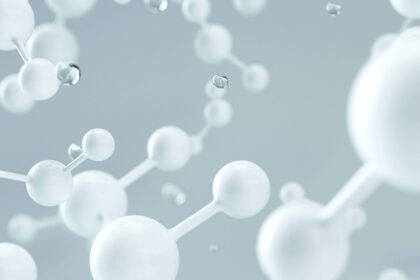Let’s ensure we’re all on the same page by first reviewing the definition of elasticity:
- According to the Oxford Learner’s Dictionary – “elasticity is the quality that something has of being able to stretch and return to its original size and shape”. [1]
What is hair elasticity?
Hair elasticity is the ability of the hair to stretch and return to its original length without breaking. The stretchability of your hair is an indicator of the strength of the bonds that hold the hair’s fibers in place. Therefore, hair elasticity helps you to understand how healthy your hair is.
When you find yourself having to use extra caution or put extra thought into how gently you tug at your hair, you have a problem that needs to be addressed immediately.
Why is it important to understand my hair’s elasticity?
Understanding your hair’s elasticity helps you identify when your hair’s balance is disrupted. Certain changes to your hair tell you that it may be lacking something which has led to you experiencing challenges like excessive shedding, weak, dry, dull, and breaking hair. When you make it to this point, your hair is trying to tell you that it either lacks moisture or protein. This can be described as a protein moisture imbalance. In some cases maybe there is something you need to do less of or stop.
How to find and maintain balance in your hair
To maintain balance hair needs both protein and moisture. Some persons may benefit from deep conditioning treatments, whereas some persons may benefit from protein treatments.
Finding your balance requires that you first identify the problem(s) like “it breaks easily” or “stretches a lot”.
- Here are some questions to help you identify the problems you have with your hair.
Maintaining your balance requires identifying products and a routine that meet your needs, and consistently implementing the use of such products and routines.
What are some identifiers of hair elasticity?
Some characteristics to look for before testing hair elasticity are:
High Elasticity
- High elasticity hair tends to be abnormally stretchy in its dry state, this is exacerbated when wet.
- May be overly frizzy, fluffy, and feel overly soft when dry or gummy/mushy when wet and breaks easily or often when dry.
- May not hold any style well or for long periods whether it be from chemical, heat, or wet setting.
- May require additional care during chemical processes or might not be able to do the service due to excessive amounts of damage
Normal Elasticity
- Healthy wet hair with normal elasticity may stretch up to 50% of its original length while dry hair stretches about 20% of its length and returns to the original length without breaking.
- depending on the hair type, healthy hair may have zero to small amounts of frizz, but not enough to be concerned about
- Holds styles very well and tends to be very flexible in terms of styling options and how it reacts to chemical processing.
Low Elasticity
- Hair with low elasticity may be brittle and breaks easily when wet or dry.
- May feel stiff and frizzy
- May not hold any style well or for long periods whether it be chemical, heat, or wet styling.
- May require additional care during chemical processes or might not be able to do the service due to the hair’s resistance to processing
How do I find out my hair’s elasticity?
You can find out what your hair elasticity is by doing a simple test. For best results test on cleansed hair.
Keep in mind that wet hair is more pliable than dry hair and will stretch more. Hair is also more vulnerable to damage when wet, so proceed with caution.
Hair elasticity test
On a strand of cleansed wet or dry hair hold the strand on opposite ends (from root to tip) and gently pull in either direction as much as you can without breaking the hair, then allow the hair to relax and observe it. Avoid using excessive force as this will throw off your results:
- High Elasticity – can be very stretchy and does not return to its original shape or length, for example.:
- Kinky/Coily/Curly hair – once stretched, may relax in a wavy or straight pattern and does not return to its pre-stretched length.
- Wavy hair – once stretched, may relax in a straight or less wavy pattern and does not return to its pre-stretched length.
- Straight hair – will not return to its pre-stretched length.
- Medium/Normal Elasticity – It will stretch a reasonable amount before breaking. Your hair strand returns to its pre-stretched texture and length. Great job! Keep doing what you’re doing.
- Low elasticity – if the hair breaks with little force, it is considered to have low elasticity.
Are you thinking it? Let’s entertain the thought and compare our strands to an elastic band. When stretched and released, the band quickly snaps back to its original shape and length. If the rubber band is extremely dry or worn, then it may crack, break or remain in a stretched state. Your hair is the same.
What gives hair its elasticity?
Side bonds such as hydrogen bonds, salt bonds, and disulfide bonds keep hair in its natural shape and give hair its strength and elasticity. Hydrogen bonds are temporary bonds that break when heat or water is applied and cause hair to be more flexible. These bonds give your hair its elasticity.
What stops hair from breaking when stretched?
Permanent bonds known as Disulfide bonds which stitch the proteins called ‘Keratin’ in your hair together make hair strong and resistant to breaking.
Does hair elasticity change?
Yes.
What causes hair elasticity to change?
Water and heat temporarily break down something called hydrogen and salt bonds, making it easier to style your hair, and certain chemicals permanently break down disulfide bonds making it possible to manipulate your hair’s shape (kinks, coils, curls, waves, straight). When these bonds are weakened or broken this can alter your protein and moisture balance.
When the balance of protein and moisture is disrupted, over time elasticity changes
Reasons hair Elasticity changes
- Chemical processes – permanently change and weaken disulfide bonds.
- Relaxers
- Permanent and semi-permanent hair coloring
- Lightening/bleaching hair
- Perms
- Swimming – permanently weakens disulfide bonds in hair fibers.
- Excessive or improper use of heat styling tools – When heat is used hydrogen bonds are temporarily broken, however excessive or improper use of heat can lead to permanently broken bonds.
- flat irons
- blow dryers
- wands and other irons
- hot combs
- Washing – Water temporarily breaks down hydrogen and salt bonds, however excessive or improper use of water can lead to permanently broken bonds.
- Using the wrong hair products – salt bonds are temporarily broken down in the presence of a pH above 5.5. Permanent damage may occur when the hair’s pH is regularly disrupted, or when the pH of a product is too high for the hair.
- Brushing and combing hair
- Friction
- Use of wrong brushes and combs
- Environmental factors – degradation due to structural damage caused by UVA & UVB as well as the temporary breakdown of hydrogen and salt bonds due to water & heat, etc.
- UV rays
- Wind
- Rain
- Humidity – moisture in the atmosphere
- Hormonal changes
- Diet
- Nutritional deficiencies like:
- Protein
- Vitamins and minerals
- Zinc
- Biotin
- Nutritional deficiencies like:
- Medication
- Chemotherapy
Using your elasticity test results to your advantage
Although high and low-elasticity hair may share similar characteristics, when you understand your hair’s elasticity, you have empowered yourself to make wise health and purchasing decisions quickly and effectively. Plus, you say goodbye to the “product graveyards” and “buyer’s remorse”.
Summary
Your hair’s elasticity is an indicator of the overall health and strength of your hair, which can also be used as an indicator of your own personal health or hair care habits that may or may not be serving you.









